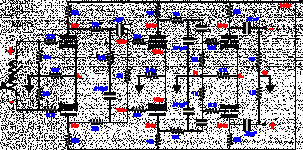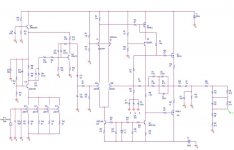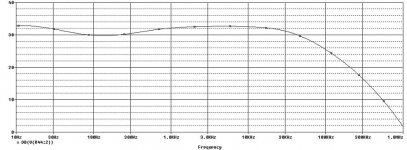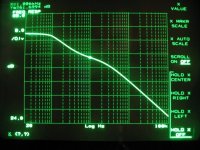i wanted to know a couple of things if possible:
1- does the circuit have no thump at the powering on/off moment? so is the output relay only used for muting purposes?
About the balance circuit: this ONO doesn't seem to me to be a real balance topology except for a phase inverter at the output that still makes available a balance output but yet doesn't make it a real balance circuitry.
here where my other connected doubt lays on:
2- i have never seen them around and thus i don't know, if such a thing exists or not but, nevertheless, is it possible to have a balance signal at the output of a cartridge?
3- in case point 2 is realizable somehow, wouldn't it be possible and/or has anybody ever tried to use UGS modules in a phono stage?
i hope these questions and especially the last one, won't be as stupid as they look
1- does the circuit have no thump at the powering on/off moment? so is the output relay only used for muting purposes?
About the balance circuit: this ONO doesn't seem to me to be a real balance topology except for a phase inverter at the output that still makes available a balance output but yet doesn't make it a real balance circuitry.
here where my other connected doubt lays on:
2- i have never seen them around and thus i don't know, if such a thing exists or not but, nevertheless, is it possible to have a balance signal at the output of a cartridge?
3- in case point 2 is realizable somehow, wouldn't it be possible and/or has anybody ever tried to use UGS modules in a phono stage?
i hope these questions and especially the last one, won't be as stupid as they look
Balanced cartridge
Yes, of course you could have a balanced phono-cartridge..... I've seen them but not for decades. When they were around, as I recall they were moving magnet.
Having said all that, the industry has long accepted the standard that a phono-cartridge is single ended.
Cyclotronguy
Yes, of course you could have a balanced phono-cartridge..... I've seen them but not for decades. When they were around, as I recall they were moving magnet.
Having said all that, the industry has long accepted the standard that a phono-cartridge is single ended.
Cyclotronguy
interesting, thank you very much for your post, i didn't know that!
After all, pick up are single end, thus, what would make sense: convert a signal originally born as single end or keep it that way?
If Vinyl is far off the best way of reproducing music, would it still make sense to have a balance stereo chain or better keep it all single end?
I was also thinking that question 3 is a little bit tricky.
Since Mr. Pass developed the Xono a little while ago and he basically kept the Ono circuitry/topology then it might be not possible and/or not so convenient, to use the Super Symmetric on a phono stage.
what do you guys think about this?
Has anybody here ever tried/experimented the UGS in a phono stage?
After all, pick up are single end, thus, what would make sense: convert a signal originally born as single end or keep it that way?
If Vinyl is far off the best way of reproducing music, would it still make sense to have a balance stereo chain or better keep it all single end?
I was also thinking that question 3 is a little bit tricky.
Since Mr. Pass developed the Xono a little while ago and he basically kept the Ono circuitry/topology then it might be not possible and/or not so convenient, to use the Super Symmetric on a phono stage.
what do you guys think about this?
Has anybody here ever tried/experimented the UGS in a phono stage?
Basically all cartridges (ok, i haven't used a MM cart for about 30 years so no opinion about those) produce balanced output. It is the wiring of the arm that may limit the output signal to SE.
There are also fully balanced phono stages - just double all the components and voila.
As for the UGS i don't expect it to be suitable unless it's possible to raise the gain a lot. No idea if the noise performance is ideal but a step-up transformer will likely help. And it will preserve the balanced signal.
There are very polarised opinions about the desirability of balanced phono. I distinctly remember JC per example not being a fan.
There are also fully balanced phono stages - just double all the components and voila.
As for the UGS i don't expect it to be suitable unless it's possible to raise the gain a lot. No idea if the noise performance is ideal but a step-up transformer will likely help. And it will preserve the balanced signal.
There are very polarised opinions about the desirability of balanced phono. I distinctly remember JC per example not being a fan.
Originally posted by analog_sa [/i
There are also fully balanced phono stages - just double all the components and voila.
wouldn't that be quadruple? =)
luvdunhill said:
wouldn't that be quadruple? =)
Only if you insist on split riaa. Tubecad have a nice example which is easy but uninteresting to implement in SS. Unless you cascade three UGS stages
Attachments
analog_sa said:Basically all cartridges (ok, i haven't used a MM cart for about 30 years so no opinion about those) produce balanced output. It is the wiring of the arm that may limit the output signal to SE.
There are also fully balanced phono stages - just double all the components and voila.
As for the UGS i don't expect it to be suitable unless it's possible to raise the gain a lot. No idea if the noise performance is ideal but a step-up transformer will likely help. And it will preserve the balanced signal.
There are very polarised opinions about the desirability of balanced phono. I distinctly remember JC per example not being a fan.
How would you wire out the tonearm in order to obtain a full balance signal?
If i don't \ recall wrong, UGS can gain up to 30dB and therefore 3 of them in cascade would gain over 80dB which is over 10000times which is good match even with a very low voltage output cartridge as for example a 0.22mV.
i don't know if that would work out in practice though.
Would it be possible to extend the design of the ONO and make it completely balance?
When you said double the components, you meant, you would cut the phase inverter out and double the circuit to get the negative side?
Would you see real benefit from doing this?
But then: why would Nelson use a phase inverter instead of doubling all the parts as you suggested?
Just a cost matter concern or what?
Hi Stefano
Won't answer all your questions as i'm about to sleep.
Your gain calc is wrong as you don't take into account the losses in a (passive) riaa network - about 20db.
Making the Ono balanced is quite difficult. It is basically an opamp with a frequency dependent feedback. To make it balanced will require a major redesign. And for what? Most designers don't see an advantage of fully balanced phono stages. Probably because of incompatibilities with customer's equipment.
In any case i think a groundbreaking Pass phono stage is long overdue
Won't answer all your questions as i'm about to sleep.
Your gain calc is wrong as you don't take into account the losses in a (passive) riaa network - about 20db.
Making the Ono balanced is quite difficult. It is basically an opamp with a frequency dependent feedback. To make it balanced will require a major redesign. And for what? Most designers don't see an advantage of fully balanced phono stages. Probably because of incompatibilities with customer's equipment.
In any case i think a groundbreaking Pass phono stage is long overdue
Thank you very much for your reply.
Just wondering if:
- the 2SK389 are BL types and 2SK170 are BR types?
- on a post i found on this forum Nelson said to replace the 2SC1844 and 2SA991 with high quality 60V NPN and PNP(not all of them but oh well), is there any advice on what to use for these devices?
I am simulating the ONO with PSpice.
Since i don't get really straight how and if the RIAA circuit works i connected at the output the Inverse RIAA circuit taken from the webpage:
http://www.hagtech.com/pdf/riaa.pdf
by doing the frequency analysis i get some weired results going on.
To see if anybody might give me some tips to understand what's wrong with it.
Here is the circuit used
Just wondering if:
- the 2SK389 are BL types and 2SK170 are BR types?
- on a post i found on this forum Nelson said to replace the 2SC1844 and 2SA991 with high quality 60V NPN and PNP(not all of them but oh well), is there any advice on what to use for these devices?
I am simulating the ONO with PSpice.
Since i don't get really straight how and if the RIAA circuit works i connected at the output the Inverse RIAA circuit taken from the webpage:
http://www.hagtech.com/pdf/riaa.pdf
by doing the frequency analysis i get some weired results going on.
To see if anybody might give me some tips to understand what's wrong with it.
Here is the circuit used
Attachments
And this is the plot of the magnitude at the output of the inverse RIAA block.
Why don't i get a flat trace? Is this normal?
I guess there is something wrong ether on the RIAA filter or on the inverse RIAA i am using.
May anybody out there help me out with this a little bit?
Why don't i get a flat trace? Is this normal?
I guess there is something wrong ether on the RIAA filter or on the inverse RIAA i am using.
May anybody out there help me out with this a little bit?
Attachments
Stefanoo, maybe you should progress in small steps? Read about RIAA and what it's doing? Then you'll understand that you never get a perfectly flat response with real world parts.
If you calculated the deviation from the perfect line you would find only 0.5dB and compare that value to the Ono-manual.
Oh and if you want to understand how the Ono works, try to understand the basic building blocks first (I mean the various basic circuits like common-gate, common-drain, common-source). Spice won't tell you how the Ono's working, infact you will often see that Spice isn't working properly at all - but how should you know if you don't understand the circuit?
The K389 is fed by a current source, so more or less independant of max IDss.
Have fun, Hannes
EDIT: Oh I'm sorry! Your axis is already in dB! See, Spice already playing tricks with you By the way 30dB gain is a bit too less, even for MM.
By the way 30dB gain is a bit too less, even for MM.
If you calculated the deviation from the perfect line you would find only 0.5dB and compare that value to the Ono-manual.
Oh and if you want to understand how the Ono works, try to understand the basic building blocks first (I mean the various basic circuits like common-gate, common-drain, common-source). Spice won't tell you how the Ono's working, infact you will often see that Spice isn't working properly at all - but how should you know if you don't understand the circuit?
The K389 is fed by a current source, so more or less independant of max IDss.
Have fun, Hannes
EDIT: Oh I'm sorry! Your axis is already in dB! See, Spice already playing tricks with you
h_a said:
By the way 30dB gain is a bit too less, even for MM.
There is a -40db attenuation from the inverse riaa.
Stefano
Not sure what driving impedance the inverse riaa expects but it's unlikely to be 150ohm. You may need to modify the 1.91k resistor respectively.
There is a -40db attenuation from the inverse riaa.
Thank you! Yes I missed that completely. Have fun, Hannes
h_a said:
If you calculated the deviation from the perfect line you would find only 0.5dB and compare that value to the Ono-manual.
unfortunately it looks like 3.5dB of deviation from the flat response more than 0.5dB.
Isn't it too much?
Stefanoo, come on! You're a clever guy, you don't need simple yes/no replies!
and this
gives a yes, you can use also GR or BL, even a V.
In the same posting Nelson suggested also some equivalents, so just get these?
fits nicely to
and
Everything clear now?
Have fun! Hannes
Still my questions on BL or GR's types
and this
The K389 is fed by a current source, so more or less independant of max IDss.
gives a yes, you can use also GR or BL, even a V.
high quality NPN/PNP 60V
In the same posting Nelson suggested also some equivalents, so just get these?
unfortunately it looks like 3.5dB of deviation from the flat response
fits nicely to
Spice already playing tricks with you
and
Spice won't tell you how the Ono's working, infact you will often see that Spice isn't working properly at all - but how should you know if you don't understand the circuit?
Everything clear now?
Have fun! Hannes
....mas o menos està todo clarito 
but i remember nelson giving the MPSA as replcaments for the "less important" transistors and suggest to get high quality 60V parts for the rest.
I might check the post one more time to confirm what i have just said above.
Anyways, for the deviation from the ideal/flat response, i still think the RIAA regulation, in my case, is a little bit odd due to the 3.5dB of deviation.
Anybody wants to say something about this?
t h a n k s in advance.
but i remember nelson giving the MPSA as replcaments for the "less important" transistors and suggest to get high quality 60V parts for the rest.
I might check the post one more time to confirm what i have just said above.
Anyways, for the deviation from the ideal/flat response, i still think the RIAA regulation, in my case, is a little bit odd due to the 3.5dB of deviation.
Anybody wants to say something about this?
t h a n k s in advance.
Stefanoo said:Anyways, for the deviation from the ideal/flat response, i still think the RIAA regulation, in my case, is a little bit odd due to the 3.5dB of deviation.
Did you test my suggestion about the 150ohm resistor and its effect on the 1k91?
These are REAL frequency response measurement of the Ono I built for a friend of mine.
They have been taken with my Agilent analyzer, and are the f.r. of all the stages, from MC input to output. The other channel is exactly the same!
One is the real RIAA (plus gain) frequency response, the other with David Manley's inverse-RIAA network.
As you can see the line is quite flat, ant the two -2.5dB points are located to 5Hz and 100KHz.
Of course, so high frequency behaviour is to be evaluated with RIAA > Inverse-RIAA combination...
They have been taken with my Agilent analyzer, and are the f.r. of all the stages, from MC input to output. The other channel is exactly the same!
One is the real RIAA (plus gain) frequency response, the other with David Manley's inverse-RIAA network.
As you can see the line is quite flat, ant the two -2.5dB points are located to 5Hz and 100KHz.
Of course, so high frequency behaviour is to be evaluated with RIAA > Inverse-RIAA combination...
Attachments
- Status
- This old topic is closed. If you want to reopen this topic, contact a moderator using the "Report Post" button.
- Home
- Amplifiers
- Pass Labs
- Some questions on (X)-ONO




